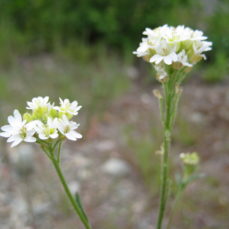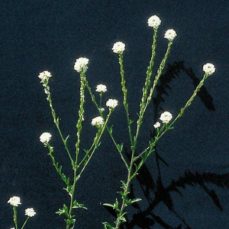Hoary Alyssum (Berteroa incana)


Management Strategy
Squamish
Whistler
Pemberton
Vectors of Spread
Synonyms
- Hoary berteroa
- Hoary false alyssum
- Hoary alison
- Hoary false madwort
ID Characteristics
General: Hoary alyssum is an annual, biennial or short-lived perennial herb.
Flowers: Rounded clusters of small, white flowers, with deeply notched petals. Petals are 4 – 6 mm long, and sepals are hairy and transient.
Stems: Erect, thin stems branch near the top. Plants can have either single or multiple stems. Hoary alyssum stems are covered in whitish, star-shaped hairs; overall, the stems are 0.3 – 1 m tall.
Leaves: Upper leaves are elliptical, face upward, lack stalks and clasp the stem. Lower leaves have long, slender stalks and are 3 – 5 cm long. Both upper and lower leaves have rough, star-shaped hairs.
Seeds: Hoary alyssum seeds are flattened, oval seed pods (5 – 6 mm long). They are held close to the stem and have star-shaped hairs. Each pod contains 4 – 12 seeds.
Roots: Slender taproot.
Similar Species
Non-native (exotic):
Pale alyssum (Alyssum alyssoides) is an annual or biennial herb with multiple, erect stems that branch near the base of the plant. The leaves are 5 – 25 mm long, narrow and covered in grey star-shaped hairs. Flowers are white or cream-coloured, are 3 – 4 mm long and covered in star-like hairs. Pale alyssum can be found growing along roadsides and waste areas.

Pale Alyssum (V. Skilton)
Desert alyssum/Desert madwort (Alyssum desertorum) is a herbacious annual that is native to Africa, Asia and Europe. It has multiple, erect stems that branch near the base of the plant and can grow to 30 cm tall. Leaves are linear or broadest at the tip. Flowers form from the bottom of the plant as the inflorescence grows and have four pale yellow or white-ish petals.

Wall alyssum (Alyssum murale) is a perennial herb with multiple, erect stems that branch near the base of the plant and can be between 25 – 70 cm tall. The basal leaves are egg-shaped, and stem leaves are 10 – 20 mm long, 3 – 6 mm wide, lanceolate and covered in grey, star-like hairs. Flowers are less than 2 – 3.5 mm long, with narrow yellow petals. It grows in dry, disturbed areas and waste places.

Wall alyssum (T. Griffin)
False flax(Camelina sativa) is an annual plant that can grow 30 – 90 cm tall. Stems are branched, become woody at maturity and are generally smooth. Leaves are arrow-shaped and 2.5 – 8.5 cm long. Flowers are small and pale yellow or a greenish-yellow with 4 petals.

Habitat and Origin
Native to Eastern and Central Europe, it was first discovered in Ontario in 1893 and was likely brought over unintentionally as a clover and alfalfa seed contaminant.
Hoary alyssum is well adapted to disturbed, dry, sandy, gravelly, and nutrient-poor soils. It prefers idle areas, over-grazed or stressed pastures or meadows, hayfields, roadsides and railways. Hoary alyssum can withstand cold winters and dry, hot summers.
How it Spreads
Hoary alyssum is an annual, biennial or short-lived perennial that reproduces solely by seed. Germination occurs from early spring through to fall. Each plant can produce up to 2,600 seeds under ideal conditions; the seeds can remain viable in the soil for up to nine years, which leads to the rapid formation of a seed bank.
Hoary alyssum seeds are dispersed through valves in the seed pods. Seeds are often present as a contaminant in hay, but they are also spread by vehicles, equipment, footwear, wildlife and birds.
Impacts
Ecological:
- Out-competes native plants and displaces weak native plant communities.
Economic:
- Decreases forage value as mature plants are low in crude proteins and digestible carbohydrates.
Health:
- Toxic to horses if eaten; ingestion can result in illness and occasionally death.
Stop the Spread
Hoary alyssum is found in the Sea to Sky region, but with a limited distribution. The goal is to contain this species from ISMAs 1 and 2, and to prevent new introductions.
Learn to identify hoary alyssum: use the images presented in this profile page to learn how to identify hoary alyssum.
What to do if you spot it: You can report any hoary alyssum sightings by visiting our reporting page.
DO:
- Regularly monitor properties for weed infestations.
- Ensure soil and gravel are uncontaminated before transport.
- Check wildflower mixes to ensure that they do not contain hoary alyssum.
- Ensure that plants are disposed of in a garbage bag if found in floral arrangements to prevent seeds from spreading.
DO NOT:
- Unload, park or store equipment or vehicles in infested areas; remove plant material from any equipment, vehicles or clothing used in such areas and wash equipment and vehicles at designated cleaning sites before leaving infested areas.
- Plant hoary alyssum in a garden, no matter how well-contained its enclosure may seem.
- Move soil that has been contaminated with hoary alyssum.
- Compost hoary alyssum.
Control
Mechanical:
Mowing early in the year can be effective, but avoid mowing mature plants as the roots will regrow. Hand-pulling small infestations can also be effective, but may be difficult as this species has a deep taproot that can grow in dry conditions.
Chemical:
A combination of 2,4-D and dicamba has been proven most effective for hoary alyssum control. Glyphosate, 2,4-D, dicamba and metsulfron methyl can also be used effectively on their own. Applying herbicide in the spring (when plants are actively growing and before bolting) is most effective. As hoary alyssum germinates and establishes throughout the growing season, repeated applications will be needed to target plants regenerating from the seed bank.
We recommend that any herbicide application be carried out by a person holding a valid BC Pesticide Applicator Certificate. Before selecting and applying herbicides, you must review and follow herbicide labels and application rates; municipal, regional, provincial and federal laws and regulations; species-specific treatment recommendations, and site-specific goals and objectives.
Biological:
There are currently no biocontrol agents available for hoary alyssum.
Sea to Sky Distribution
Hoary Alyssum Factsheet
Having trouble viewing the factsheet? Don’t worry, all the information is included on this page. You can also contact us with any questions.
Additional Resources
References
- Alberta Agriculture and Forestry, Hoary Alyssum
- Electronic Atlas of the Flora of BC, Alyssum alyssoides
- Electronic Atlas of the Flora of BC, Alyssum desertorum
- Electronic Atlas of the Flora of BC, Alyssum murale
- Electronic Atlas of the Flora of BC, Berteroa incana
- Electronic Atlas of the Flora of BC, Camelina sativa
- Fraser Valley Invasive Species Society, Hoary Alyssum
- Government of BC, “Hoary Alyssum” in A Guide to Weeds in British Columbia
- Invasive Species Council of BC, Hoary Alyssum
- Invasive Species Council of BC, Hoary Alyssum Factsheet
- Lillooet Regional Invasive Species Society, Hoary Alyssum
- Okanagan Invasive Species Online, Hoary alyssum
- University of California Weed Research & Information Centre, “Hoary Alyssum” in Weed Control in Natural Areas in the Western United States
- University of Minnesota Extension, Hoary alyssum: the most common poisonous plant to horses in Minnesota










